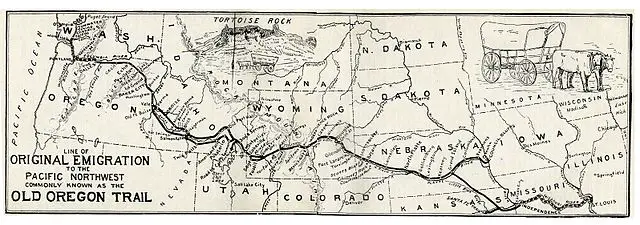Oregon Trail
As settlers migrated to the west, they established specific routes that would allow them the best course to travel. The Oregon Trail was discovered by the famous exploration team of Lewis and Clark and started in Independence, Missouri, meandered through six states to end up in what is now the state of Oregon.
Families would load up all of their belongings in covered wagons and often go in wagon train groups for safety. They traveled through what is now the states of Missouri, Kansas, Nebraska, Wyoming, Idaho, and then Oregon.

Thousands of people took this hazardous 2,000-mile journey between 1841 and 1869, crossing the Rocky Mountains and the Sierra Nevada Mountains. The Oregon Trail was one of two routes to head westward. The other was the Santa Fe Trail that ended up in New Mexico.
The pioneers that decided to go west and settle into the new areas of the country were not only pioneers. They had a sense of adventure. Some have said that this attitude has remained in many of their descendants, as well as those that arrived in the future.
The most common way to travel was in “Prairie Schooners.” These were covered wagons that looked a little bit like boats skimming over the vast prairies. These wagons were constructed from wood, with sturdy iron around the wheels.
They covered the top with a waterproof linen or cotton canvas. The average size of the wagons was 10 ft long and 4 ft wide and was pulled by oxen or mules.
The speed of traveling was slow, mainly because the wagons could weigh as much as 2,500 pounds, and the oxen or mules were slow at pulling such weights.
The terrain along the prairies was fairly easy, and in some cases, the pioneers would walk beside the wagons. However, once they got to the Rocky Mountains, there were steep hills, and the going got pretty rough.
It is difficult for us to imagine the kinds of dangers that the westward pioneers faced every day. They would often travel through areas where only Native Indians lived, and history shows that the Natives would help the pioneers.
Between bad weather, trying to get the heavy wagons over the hills and mountains, and the common disease of cholera, many of the settlers didn’t make it to the final point of their journey.

Packing for this kind of trip meant that the pioneers took only what was absolutely necessary. The left many of their cherished things behind and instead had to focus on things like 1,000 lbs of food for a family of four and cooking utensils such as iron skillets, coffee pot, and a few buckets.
Food most often included coffee, bacon, rice, beans, hardtack, and flour. These were items that they could preserve and use for multiple purposes. Most of the pioneers could only take two to three sets of clothing, and these had to be durable to withstand the trip. They also took along candles and a rifle for protection and hunting.
All of the wagons had basic tools that might be needed, such as a shovel and ax, and for sleeping, they had bedding and tents.
As more and more wagons took the trip on the Oregon Trail, they would report that many before them had thrown out some of their wagon contents along the way.
This was often done to lighten the load of the wagon as they headed up and over hills and mountains. Those that arrived at their final destination said that they saw things like heavy trunks, stoves, and even books along the roadside.
What did you Learn?
Who discovered the Oregon Trail?
Lewis and Clark
What was the length of the Oregon Trail?
Around 2,000 miles
Where did the trip for the Oregon Trail begin?
Independence, Missouri
What were the five states that encompassed the Oregon Trail?
Missouri, Kansas, Nebraska, Wyoming, Idaho, and Oregon
What was the name of the wagons that the pioneers traveled in over the Oregon Trail?
Prairie Schooners
What disease was common among the travelers of the Oregon Trail?
Cholera



